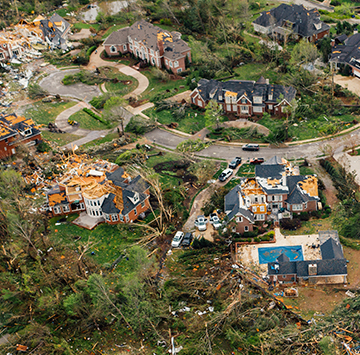Hurricanes are one of the worst disasters in terms of loss of life and damage to property. Unfortunately, some scientists are speculating that 2022 may be another bad year for hurricanes because of warmer water in the Gulf of Mexico.
Governments, municipalities and utility companies should be prepared and on alert for massive storm damage. Hurricane cleanup, including debris clearing and damaged tree removal, should ideally be budgeted for in advance, if possible.
The Risk of Hurricanes in 2022 and Beyond
The Atlantic hurricane season runs from June 1-November 30. While the chance for hurricanes usually peaks around early- to mid-September, August can also be a big month for hurricanes. While most hurricanes hitting the United States happen during the months of June to November, 3% can still occur beyond the typical hurricane season.
Will 2022 end up being a record-breaking year for hurricanes? We won’t fully know if this year is record setting until hurricane season passes, but it looks like 2022’s weather conditions are especially good for massive tropical storms.
Why? Scientists have noted that the “Loop Current,” which is a stream of warmer water that comes up from the Gulf Stream current and warms the Gulf of Mexico, had already traveled far into the Gulf of Mexico by mid-May, much farther than usual.
A warmer Loop Current has the potential to feed larger storms and create massive hurricanes. Hurricanes need warmer water if they want to grow.
Unfortunately, the 2022 Loop Current pattern mirrors the path of the Gulf current in 2005, which is when the deadly Hurricane Katrina hit. Thus, the Northern Gulf Coast, including areas between Texas, Louisiana and Florida, are a great risk for massive storms throughout this hurricane season.
The Costs of Deadly Hurricanes
Hurricanes are extremely costly, both from a human life perspective and economically. According to NOAA, between 2019 and 2021 alone, the United States experienced 56 weather and climate disasters with costs exceeding $1 billion.
Tropical cyclones or hurricanes caused the most damage and death between 1980 and 2021, with $1.1 trillion in total damage and 6,697 deaths. The cost of all this hurricane damage averages out to $20.5 billion per hurricane (of course, some were far more damaging than others, such as Hurricane Katrina).
But who pays for hurricane clean up in the United States?
Hurricane Cleanup: Who Pays?
A variety of entities end up picking up the tab for hurricane damage, from the federal government to local municipalities. Beyond federal and state disaster relief funding, local governments are often required to tap into reserve funds or utilize credit to fund hurricane cleanup.
Insurance companies may cover some of the costs, but individual homeowners are often left with a large chunk of the cleanup bill.
Local and regional utility companies also need to dig into budgets to pay for necessary infrastructure repair, including utility line repair and tree clearing.
Vegetation Management and Tree Clearing
One of the main sources of damage during a hurricane are trees and vegetation, which can quickly get entangled in power lines or worse, become uprooted. Trees can cause a number of problems during and after a massive tropical storm including:
Fallen Branches and Debris
During a hurricane, tree branches can often fall and bring structures as well as utility lines down with them. The debris can get in roads and block travel, causing all sorts of havoc.
Uprooted and Broken Trees
It’s not uncommon for tree trunks to snap completely during a hurricane, which can cause property damage and death. These fallen trees can also be a major source of power outages. Trees are also often completely uprooted during hurricanes, especially when soil is moist from heavy rainfall.
Unstable Trees
Trees can shift after a hurricane due to the erosion of the soil as well as flooding. If the tree’s roots are saturated for a long time with water, they can drown, which can lead to root rot. Once this happens, the trees are prone to falling, which can cause problems with power lines and put people in danger.
Proactive Vegetation Management to Reduce Hurricane Costs
Because of all the dangers that can come from hurricane tree damage, it is very important for municipalities and utility companies to be proactive about cleaning up trees that might be harmed during a hurricane.
Ongoing, proactive vegetation management before a hurricane hits can help reduce the problem of trees harming power lines and transformers if a storm does barrel through the area.
During extremely strong storms, of course, even the most well-maintained, stable trees can be harmed, but if excess vegetation and sick trees are pruned prior to a storm, then there will be fewer chances of problems.
Keeping trees properly trimmed before a storm can potentially save costs, as it is far cheaper to maintain vegetation proactively than fix damage caused by a tree in a howling storm.
Tree Service Providers for Hurricane Preparedness
One of the most important entities involved in hurricane cleanup is a tree service provider (like Townsend Tree Service), which can be brought in to help municipalities and utility companies for emergency storm response. Tree service providers should also be tapped to clear vegetation proactively, on an ongoing basis.
Also, if a hurricane is forecast to hit an area, it’s a good idea to contact a tree service provider such as Townsend Tree Service ahead of time. If there is sufficient time ahead of the storm, the tree service provider can assess the trees that are close to power lines and prune or clear out any that are growing too close or at risk of falling during a massive storm.
Townsend Tree Service is a leading, multi-state provider of expert tree trimming, line clearing and vegetation management services. We have extensive expertise helping utilities get the power back on after major disasters like hurricanes. Learn more about our integrated vegetation management services here.
